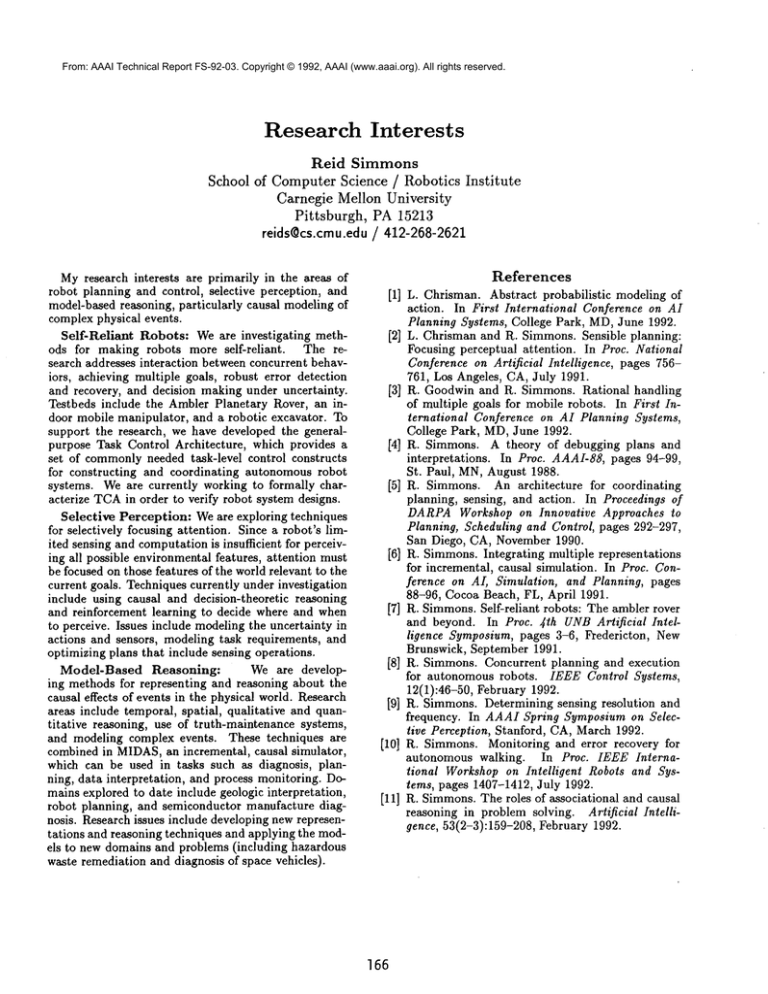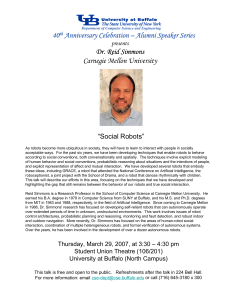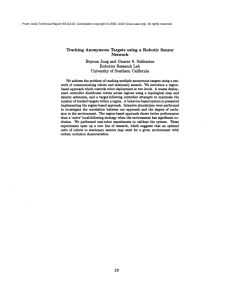
From: AAAI Technical Report FS-92-03. Copyright © 1992, AAAI (www.aaai.org). All rights reserved.
Research
Interests
Reid
Simmons
School of Computer Science / Robotics Institute
Carnegie Mellon University
Pittsburgh,
PA 15213
reids@cs.cmu.edu / 412-268-2621
Myresearch interests are primarily in the areas of
robot planning and control, selective perception, and
model-based reasoning, particularly causal modeling of
complex physical events.
Self-Reliant Robots: We are investigating
methods for making robots more self-reliant.
The research addresses interaction between concurrent behaviors, achieving multiple goals, robust error detection
and recovery, and decision making under uncertainty.
Testbeds include the Ambler Planetary Rover, an indoor mobile manipulator, and a robotic excavator. To
support the research, we have developed the generalpurpose Task Control Architecture, which provides a
set of commonlyneeded task-level control constructs
for constructing and coordinating autonomous robot
systems. Weare currently working to formally characterize TCAin order to verify robot system designs.
Selective Perception: Weare exploring techniques
for selectively focusing attention. Since a robot’s limited sensing and computationis insufficient for perceiving all possible environmental features, attention must
be focused on those features of the world relevant to the
current goals. Techniques currently under investigation
include using causal and decision-theoretic reasoning
and reinforcement learning to decide where and when
to perceive. Issues include modeling the uncertainty in
actions and sensors, modeling task requirements, and
optimizing plans that include sensing operations.
Model-Based Reasoning:
We are developing methods for representing and reasoning about the
causal effects of events in the physical world. Research
areas include temporal, spatial, qualitative and quantitative reasoning, use of truth-maintenance systems,
and modeling complex events. These techniques are
combined in MIDAS,an incremental, causal simulator,
which can be used in tasks such as diagnosis, planning, data interpretation, and process monitoring. Domains explored to date include geologic interpretation,
robot planning, and semiconductor manufacture diagnosis. Research issues include developing new representations and reasoning techniques and applying the models to new domains and problems (including hazardous
waste remediation and diagnosis of space vehicles).
References
modeling of
[1] L. Chrisman. Abstract probabilistic
action. In First International Conference on AI
Planning Systems, College Park, MD, June 1992.
[2] L. Chrisman and R. Simmons. Sensible planning:
Focusing perceptual attention. In Proc. National
Conference on Artificial Intelligence, pages 756761, Los Angeles, CA, July 1991.
[3] R. Goodwin and R. Simmons. Rational handling
of multiple goals for mobile robots. In First International Conference on AI Planning Systems,
College Park, MD, June 1992.
[4] R. Simmons. A theory of debugging plans and
interpretations.
In Proc. AAAI-88, pages 94-99,
St. Paul, MN, August 1988.
for coordinating
[5] R. Simmons. An architecture
planning, sensing, and action. In Proceedings of
DARPAWorkshop on Innovative Approaches to
Planning, Scheduling and Control, pages 292-297,
San Diego, CA, November 1990.
[6] R. Simmons. Integrating multiple representations
for incremental, causal simulation. In Proc. Conterence on AI, Simulation, and Planning, pages
88-96, Cocoa Beach, FL, April 1991.
[7] R. Simmons.Self-reliant robots: The ambler rover
and beyond. In Proc. 4th UNBArtificial
Intelligence Symposium, pages 3-6, Fredericton, New
Brunswick, September 1991.
[8] R. Simmons. Concurrent planning and execution
for autonomous robots. IEEE Control Systems,
12(1):46-50, February 1992.
[9] R. Simmons. Determining sensing resolution and
frequency. In AAAI Spring Symposium on Selective Perception, Stanford, CA, March 1992.
[10] R. Simmons. Monitoring and error recovery for
autonomous walking. In Proc. IEEE International Workshop on Intelligent
Robots and Systems, pages 1407-1412, July 1992.
[11] R. Simmons.The roles of associational and causal
reasoning in problem solving. Artificial Intelligence, 53(2-3):159-208, February 1992.
166




